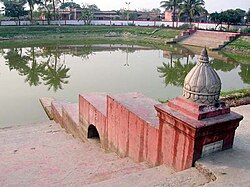Sitamarhi district
Sitamarhi district | |
|---|---|
 Janaki Kund, Sitamarhi | |
 Location of Sitamarhi district in Bihar | |
| Country | |
| State | Bihar |
| Division | Tirhut |
| Headquarters | Dumra, Sitamarhi |
| Government | |
| • Lok Sabha constituencies | Sitamarhi |
| • Vidhan Sabha constituencies | Riga, Bathnaha, Parihar, Sursand, Bajpatti, Sitamarhi, Runnisaidpur, Belsand |
| Area | |
| • Total | 2,294 km2 (886 sq mi) |
| Population (2011) | |
| • Total | 3,423,574 |
| • Density | 1,500/km2 (3,900/sq mi) |
| • Urban | 5.71 per cent |
| Demographics | |
| • Literacy | 53.53 per cent |
| • Sex ratio | 899 females \ 1000 males |
| Time zone | UTC+05:30 (IST) |
| Major highways | NH 104 |
| Average annual precipitation | 1200 mm |
| Website | https://sitamarhi.nic.in/ |
Sitamarhi is one of the districts of the state of Bihar, India. Dumra is the administrative headquarters of this district. The district is a part of the Tirhut Division and is located along the border of Nepal.
History[edit]
| Year | Pop. | ±% p.a. |
|---|---|---|
| 1901 | 782,557 | — |
| 1911 | 807,936 | +0.32% |
| 1921 | 782,221 | −0.32% |
| 1931 | 835,055 | +0.66% |
| 1941 | 921,265 | +0.99% |
| 1951 | 999,655 | +0.82% |
| 1961 | 1,158,546 | +1.49% |
| 1971 | 1,323,793 | +1.34% |
| 1981 | 1,627,716 | +2.09% |
| 1991 | 2,013,796 | +2.15% |
| 2001 | 2,682,720 | +2.91% |
| 2011 | 3,423,574 | +2.47% |
| source:[1] | ||
This place is considered as birthplace of Sita, the main character of the epic Ramayana and a temple dedicated to Sita lies near Sitamarhi town.[2] A Rock cut sanctuary of Mauryan period is found near Sitamarhi.[3]
In 1875, a Sitamarhi subdistrict was created within the Muzaffarpur district.[4] Sitmarhi was detached from Muzaffarpur and became a separate district as of 11 December 1972.[5] It is situated in the northern part of Bihar. The district headquarters is located in Dumra, five kilometers south of Sitamarhi.[clarification needed]
Sitamarhi district became a full-pledged district when it was split from Muzaffarpur district in 1972.[6] 1994 saw the split of Sheohar district from Sitamarhi.[6]
The district is currently a part of the Red Corridor.[7] There is a village in Sitamarhi District named Harpurwa. There is the tomb of Daataa Shah in Harpurwa which is famous in Sitamarhi district.
Today's Sitamarhi is a pilgrim centre catering to presentation of tradition and mythology. Its legendary association with the classic story of Ramayana gives it a place in the itinerary of a pious Hindu. Though the district of Sitamarhi is known as a religious destination, along with its shrines and temples, it also holds other attractions, such as the Kanti thermal power station, and the city of Sitamarhi offers natural vistas and fashionable buildings.
Colleges and Universities: S.R.K.G. College, Raghunath Jha College
Geography[edit]
Sitamarhi district occupies an area of 2,294 square kilometres (886 sq mi),[8] comparatively equivalent to Australia's Groote Eylandt.[9]
It is situated in flood plain area. As in August 2019, Sitamarhi district was flooded heavily.
Sub-divisions[edit]
Sitamarhi district comprises 3 Sub-divisions:
- Sitamarhi Sadar,
- Belsand,
- Pupri
Block[edit]
| 1. Dumra, Sitamarhi |
| 2. Runni Saidpur |
| 3. Parihar |
| 4. Bathnaha |
| 5. Sonbarsa |
| 6. Bajpatti |
| 7. Sursand |
| 8. Riga |
| 9. Nanpur |
| 10. Pupri |
| 11. Bairgania |
| 12. Bokhara |
| 13. Suppi |
| 14. Belsand |
| 15. Majorganj |
| 16. [Parsauni] |
17. Choraut
Economy[edit]It is one of the 38 districts in Bihar currently receiving funds from the Backward Regions Grant Fund Programme (BRGF).[10] Education[edit]The following is a list of Schools in Sitamarhi, Bihar, India
Tourism[edit]Transport[edit]National Highway 77 connects the area to the Muzaffarpur district and Patna to the South. Sitamarhi has road connections to adjoining districts, of which the major examples are National Highway 77 and National Highway 104. It is situated on the Darbhanga Narkatiaganj railway line and has the largest railway station of the district. Another broad gauge track, running between Muzaffarpur and Sitamarhi. Direct train services are available to places such as New Delhi, Kolkata, Varanasi, Hyderabad and Kanpur. State highways link it to the Madhubani (to the east) and Sheohar (to the west) districts. Railway lines connect Sitamarhi to Darbhanga in east, and to Muzaffarpur in the south and to Raxaul in the west. Sitamarhi has a railway junction. Sitamarhi railway station is on the Raxaul-Darbhanga rail route. The nearest airport to Sitamarhi is the Darbhanga Airport which is about 70 km from Sitamarhi. The Sitamarhi-Bhitthamore Road is important for religious reasons as it connects Janakpur, which houses a 200-year-old Janki Temple with Sitamarhi—considered to be the birth place of Goddess Sita.[11][12] National Highway 227 passes through Bhitthamore. Thus it is a gateway to Janakpur, Nepal and other parts of Sitamarhi & madhubani.[13] Demographics[edit]According to the 2011 census Sitamarhi district has a population of 3,423,574,[14] roughly equal to the nation of Panama[15] or the US state of Connecticut.[16] This gives it a ranking of 96th in India (out of a total of 640).[14] The district has a population density of 1,491 inhabitants per square kilometre (3,860/sq mi).[14] Its population growth rate over the decade 2001-2011 was 27.47%.[14] Sitamarhi has a sex ratio of 899 females for every 1000 males,[14] and a literacy rate of 53.53%.[14] At the time of the 2011 Census of India, 82.73% of the population in the district spoke Hindi, 13.96% Urdu and 3.25% Maithili as their first language.[17] Notable people[edit]
References[edit]
External links[edit]
Coordinates: 26°36′00″N 85°29′00″E / 26.60000°N 85.48333°E Template:Districts of Bihar Template:Minority Concentrated Districts in India Template:Tirhut Division |